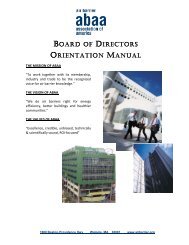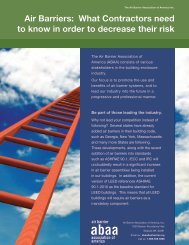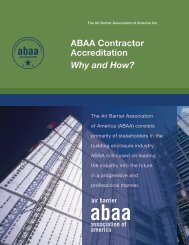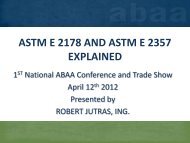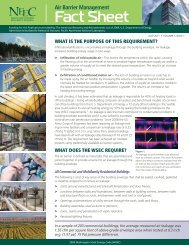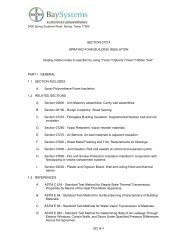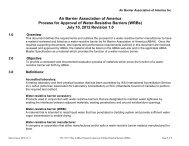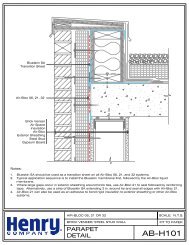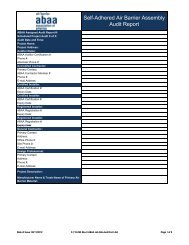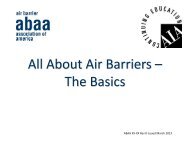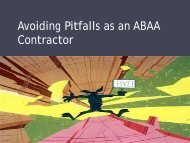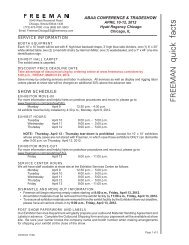Commissioning the Air Barrier System - Air Barrier Association of ...
Commissioning the Air Barrier System - Air Barrier Association of ...
Commissioning the Air Barrier System - Air Barrier Association of ...
You also want an ePaper? Increase the reach of your titles
YUMPU automatically turns print PDFs into web optimized ePapers that Google loves.
materials should be tested and qualified per ASTM E2178 not<br />
to exceed 0.004 cfm at 0.3 in. w.g. or 1.57 lbs/ft 2 (0.02 L/s·m 2<br />
at 75 Pa). 12<br />
Table 1 shows <strong>the</strong> materials tested by Canada Mortgage and<br />
Housing Corporation and <strong>the</strong>ir air leakage rates at 0.3 in. w.g.<br />
(75 Pa).<br />
Assemblies <strong>of</strong> opaque walls, curtain walls and windows can<br />
be tested in <strong>the</strong> lab in accordance with NFRC 400 or ASTM<br />
E 283 (air infiltration), ASTM E 331 (water penetration under<br />
static pressure), AAMA test procedure 501.1 (water penetration<br />
under dynamic pressure) ASTM<br />
E 330 (structural adequacy), NFRC<br />
500 or AAMA 1502.7 (condensation<br />
resistance factor or CRF), NFRC 100<br />
or AAMA 1503.1 (<strong>the</strong>rmal transmittance),<br />
NFRC 200 (solar heat gain<br />
coefficient), NFRC 300 (solar optical<br />
properties <strong>of</strong> glazing products).<br />
Ano<strong>the</strong>r test for air barrier assemblies<br />
is ASTM E1677; it is a test for<br />
low-rise residential buildings and<br />
includes an 8 ft by 8 ft (2.4 × 2.4 m)<br />
panel that has panel joints, a blanked<strong>of</strong>f<br />
window, a duct penetration, an<br />
electric outlet, etc. The maximum test<br />
pressure suggested in this test may<br />
be too low to simulate wind loads for<br />
most building locations and for taller<br />
buildings, so a test pressure more<br />
representative <strong>of</strong> design wind and<br />
gust pressures at <strong>the</strong> project site (plus<br />
a safety factor) should be required<br />
by <strong>the</strong> A/E. Infiltration is reported<br />
with this test as cfm/ft 2 at 0.3 in. w.g.<br />
(L/s·m 2 at 75 Pa).<br />
The Canadian Centre for Materials in Construction has established<br />
an elaborate test protocol for air barrier assemblies<br />
that includes three test panels. The <strong>Air</strong> <strong>Barrier</strong> <strong>Association</strong> <strong>of</strong><br />
America is bringing a similar test to ASTM and is planning<br />
within ASTM a whole family <strong>of</strong> test methods, specifications<br />
and standards for materials, assemblies and components (sealants<br />
and joint materials).<br />
Figure 6: Cutting around <strong>the</strong> disk.<br />
Figure 7: Pulling material to failure.<br />
Field Testing<br />
ASTM E 1186 contains several useful qualitative tests to chase<br />
down leaks. Infrared scanning with pressurization/depressurization<br />
is useful in determining leaks in <strong>the</strong> winter or summer. In <strong>the</strong><br />
winter, leaking warm air heats up <strong>the</strong> enclosure and shows up as<br />
a bright spot in <strong>the</strong> picture (Figure 3) (this also can be caused by<br />
a <strong>the</strong>rmal bridge, which can be identified from <strong>the</strong> design details<br />
or insulation inadequacies during construction).<br />
The reverse happens in <strong>the</strong> summer with air conditioning<br />
indoors. The dark spots are spots cooled by exiting cool air, or<br />
o<strong>the</strong>r enclosure problems.<br />
Several o<strong>the</strong>r tests within E1186 are rarely used, but two are<br />
worthy <strong>of</strong> note. Chamber pressurization/depressurization in conjunction<br />
with smoke tracers is a useful test to determine <strong>the</strong> location<br />
<strong>of</strong> air leaks in connections between building components such<br />
as windows and skylights with <strong>the</strong>ir adjacent constructions.<br />
A chamber is created using polyethylene and a simple wood<br />
frame (Figure 4), a smoke device is released, or generated<br />
using <strong>the</strong>atrical foggers, while air from a fan depressurizes or<br />
pressurizes depending on <strong>the</strong> configuration.<br />
Chamber depressurization<br />
using detection liquids uses a device<br />
nicknamed <strong>the</strong> “bubble gun” (Figure<br />
5). A bubble solution is spread on <strong>the</strong><br />
suspected penetration or joint, such<br />
as a brick tie fastened to a wall. The<br />
plastic dome <strong>of</strong> <strong>the</strong> device is placed<br />
over <strong>the</strong> area and depressurized to<br />
500 Pa (2 in. w.g.). Bubbles form if<br />
an air leak exists.<br />
The bond <strong>of</strong> <strong>the</strong> air barrier to its<br />
substrate is important because <strong>of</strong><br />
<strong>the</strong> requirement <strong>of</strong> <strong>the</strong> membrane<br />
to transfer <strong>the</strong> design wind negative<br />
loads to <strong>the</strong> substrate. Manufacturers<br />
<strong>of</strong> most air barrier products that are<br />
ei<strong>the</strong>r peel-and-stick or liquid-applied<br />
publish data on quality <strong>of</strong> adhesion to<br />
substrates. Testing using a pull-meter<br />
can be done by following ASTM<br />
D4541. A disk is epoxied to <strong>the</strong> material<br />
to be tested, and <strong>the</strong> material is cut<br />
around <strong>the</strong> disk (Figure 6). Tightening<br />
<strong>the</strong> device pulls <strong>the</strong> material to failure<br />
(Figure 7), and <strong>the</strong> test pressure is recorded and compared to <strong>the</strong><br />
manufacturer’s specifications. A 12 psi (83 kPa) minimum bond<br />
should be satisfactory for long-term durability. Note that patching<br />
<strong>of</strong> <strong>the</strong> test area will be necessary.<br />
The adhesion quality <strong>of</strong> air barrier membranes can be affected<br />
by <strong>the</strong> wetness <strong>of</strong> <strong>the</strong> substrate before application or by<br />
low application temperatures.<br />
ASTM E783 is a test for air infiltration <strong>of</strong> wall or window<br />
assemblies. ASTM E1105 is a spray rack water infiltration<br />
testing <strong>of</strong> wall or window assemblies, using <strong>the</strong> same pressurization/depressurization<br />
equipment as E783 and is usually run<br />
at <strong>the</strong> same time as E783.<br />
Whole Building Testing<br />
Testing whole commercial buildings usually is done for U.S.<br />
research, although it is more common in Canada. It has become<br />
a requirement for building acceptance in England and Wales<br />
4 0 A S H R A E J o u r n a l a s h r a e . o r g M a r c h 2 0 0 5



